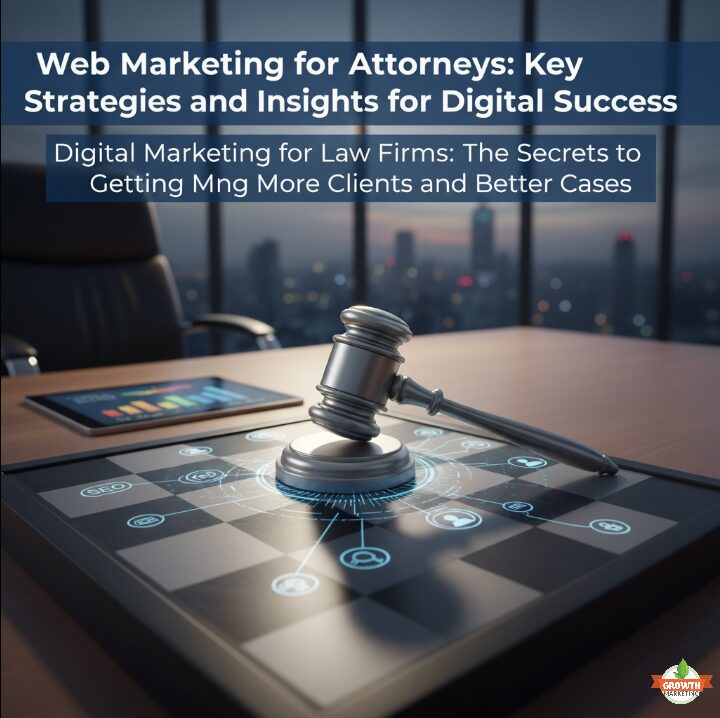SEO Meaning in Digital Marketing: Unlocking Strategies for Organic Growth and Visibility

SEO Meaning in Digital Marketing: Unlocking the Power of Organic Growth
Estimated reading time: 6 minutes
Key Takeaways
-
- SEO is essential for increasing online visibility and driving organic traffic.
-
- SEO comprises three main components: On-Page, Technical, and Off-Page optimization.
-
- Effective SEO integrates with other digital marketing strategies, enhancing overall success.
-
- Staying updated with algorithm changes and emerging trends is crucial for long-term SEO effectiveness.
- Future SEO strategies must focus on providing genuine value and optimizing for user intent.
Table of Contents
In the ever-evolving landscape of digital marketing, the term “Search Engine Optimization” (SEO) has emerged as a cornerstone strategy for businesses aiming to increase their visibility online. Understanding the meaning of SEO in digital marketing is not just a passing trend; it’s a necessity for anyone looking to thrive in a competitive digital world. This article delves deep into the essence of SEO, emphasizing its core components, strategic importance, associated challenges, and future trends, all while illustrating how it serves as a vital asset for driving organic traffic and achieving sustainable growth.
Defining SEO: What It Really Means
At its core, SEO stands for Search Engine Optimization. It involves a comprehensive set of practices aimed at enhancing a website’s visibility on search engine results pages (SERPs) for targeted keywords and phrases. Unlike paid advertising, where visibility can be bought, SEO focuses on earning organic results that naturally draw users to a website without the use of paid ads – source: Wikipedia, Search Engine Land.
The primary goal of SEO is to position a website as an authoritative resource for specific queries, attracting users who are actively seeking relevant information, products, or services. This intricate dance of enhancing online visibility is not merely technical; it is both an art and a science – source: Moz.
Understanding How SEO Works
Search engines like Google utilize complex algorithms to sift through billions of webpages. This process can be broken down into three key stages:
-
- Crawling: Automated bots, such as Googlebot, traverse the web to discover new and updated content. They follow links to understand the structure of a site – source: Moz.
- Indexing: Once a page is crawled, the information extracted is analyzed and stored in a vast database. Only indexed pages are eligible to appear in search results – source: Moz.
- Ranking: Finally, search engines assess indexed pages based on numerous ranking factors, including content quality, site speed, and backlink profiles. This evaluation determines the order in which pages appear in response to user queries – source: Coursera.
The synergy of these processes allows SEO to create a bridge between user intent and a website’s offerings, fostering a mutually beneficial relationship where search engines reward valuable content with higher visibility.
The Core Components of SEO
To effectively harness the power of SEO, it is crucial to recognize its three foundational pillars:
1. On-Page Optimization
On-page SEO involves optimizing individual web pages to enhance their relevance and readability. This entails various practices, including:
-
- Keyword Research: Identifying high-volume, low-competition keywords reflective of user queries is essential. For example, a local bookstore might target “best mystery novels in [City]” instead of just “mystery novels” – source: Coursera.
- Content Creation: Producing thorough, engaging content that addresses the needs of searchers is vital. Google’s algorithm values content that exhibits “experience, expertise, authoritativeness, and trustworthiness” (E-E-A-T) – source: Yoast.
- Metadata Optimization: Crafting compelling title tags and meta descriptions that naturally incorporate target keywords can help improve click-through rates while adhering to SEO best practices – source: Mailchimp.
2. Technical SEO
Technical SEO ensures that a website conforms to the technical requirements set by search engines for effective crawling and indexing. Key elements to consider include:
-
- Mobile-First Indexing: With over 60% of searches occurring on mobile devices, optimizing for mobile responsiveness and fast loading times is crucial for user experience.
- Structured Data Markup: Utilizing schema.org vocabulary allows search engines to understand the context of the content more clearly, leading to enhanced rich snippets in SERPs – source: Mailchimp.
- Site Architecture: Establishing a logical URL structure, using XML sitemaps, and implementing internal linking strategies can ease the crawling process and enhance content discoverability – source: Moz.
3. Off-Page SEO
Off-page SEO focuses on building a site’s credibility through external signals, primarily backlinks. High-quality links from reputable domains act as endorsements of trust and authority. Strategies such as guest blogging, digital PR, and outreach to resource pages can facilitate organic link acquisition, significantly enhancing a website’s authority in the eyes of search engines. Additionally, partnering with non-competing businesses can further amplify your off-page SEO efforts by leveraging specialized expertise.
The Strategic Importance of SEO in Digital Marketing
Synergizing with Broader Marketing Objectives
One of SEO’s most striking features is its ability to reinforce other digital marketing strategies:
-
- Content Marketing: Blog posts that target informational keywords (“how to choose the right coffee maker”) can attract users who are still in the awareness stage of their purchasing journey, gradually guiding them toward conversion-focused content – source: Shopify.
- Social Media: Engaging social content can drive initial brand awareness, while SEO captures additional search traffic when users seek more information or related topics – source: Moz.
- Email Marketing: Optimizing landing pages for transactional keywords can convert email subscribers into loyal customers, harnessing the power of organic search traffic.
Unlike pay-per-click (PPC) campaigns that cease to yield returns once budgets are depleted, SEO offers lasting benefits. A study by Terakeet shows that organic search can reduce customer acquisition costs by 87% compared to paid channels – source: Coursera.
Establishing Competitive Advantage
In today’s heavily saturated markets, effective SEO can provide smaller businesses with a fighting chance to compete with larger corporations. By targeting long-tail keywords—specific, low-competition phrases such as “eco-friendly running shoes for women”—brands can appeal to niche audiences better served by specialized content – source: Laire Digital.
For example, a small artisan soap company might struggle to rank for a broad term like “organic soap,” but could dominate the search results for “handmade lavender soap with natural ingredients” by creating engaging product descriptions and utilizing customer testimonials – source: Digital Advertising Near Me: A Comprehensive Guide to Local Marketing Strategies.
Leveraging Data for Insight and Refine Strategies
Modern SEO relies heavily on data-driven decision-making. Metrics such as organic traffic, bounce rates, and conversion rates provide a comprehensive view of performance – source: WebFX. Google Search Console is an invaluable tool that offers insights into search impressions, average position, and click-through rates (CTR), allowing marketers to make informed strategy adjustments – source: Moz.
For instance, if a website ranks #7 for “best laptop bags,” it could break into the top three by enhancing its content quality and acquiring more backlinks from tech forums – source: Digital Advertising Near Me: Your Ultimate Guide.
Challenges and Emerging Trends in SEO
The Perpetual Nature of Algorithm Updates
Search engines frequently refresh their algorithms to ensure the delivery of high-quality results. For instance, major updates such as:
-
- Core Web Vitals (2021): Emphasized key user experience metrics like page loading times, interactivity, and visual stability – source: Mailchimp.
- Helpful Content Update (2022): Targeted content that prioritizes ranking over user experience, penalizing sites that fail to deliver genuine value – source: Yoast.
- AI Content Policies (2025): Established guidelines requiring transparency for AI-generated content while maintaining standards for quality – source: Search Engine Land.
Websites that fail to adapt risk substantial traffic declines. For instance, many sites experienced drops of over 50% in traffic after the introduction of digital advertising near me mobile-first indexing.
The Growing Influence of Voice and Visual Search
With voice assistants handling around 50% of all searches, there’s a pressing need for businesses to adopt conversational keywords (“What are the best gluten-free pizza options nearby?”) – source: Search Engine Land.
Simultaneously, visual searches powered by tools like Google Lens require optimization efforts through strategies such as employing alt text, reducing image file sizes, and using descriptive filenames to enhance discoverability – source: Shopify.
AI and the Increasing Role of Automation in SEO
Generative AI tools like ChatGPT can assist with content ideation and other routine tasks. However, they cannot replace the nuanced insights that human experts provide. The most successful marketers are now leveraging AI to optimize keyword clustering and analyze backlink strategies while ensuring their content retains a unique, engaging voice – source: Search Engine Land.
Conclusion: Future-Proofing SEO Strategies
As the digital landscape continues to evolve, the importance of SEO cannot be overstated. It remains crucial for businesses to deliver genuine value to users while balancing technical precision with creative narrative. Moving forward, integrating SEO with multifaceted marketing efforts, including content creation and user experience design, will bolster resilience against ongoing technological changes.
The future of SEO is also shifting toward semantic search optimization, where search engines analyze user intent contextually rather than relying solely on exact keyword matches. Companies that prepare for this paradigm shift by investing in natural language processing (NLP) and entity-based content models will position themselves to lead in an increasingly competitive marketplace – source: Yoast.
In summary, understanding the meaning of SEO in digital marketing is essential for anyone looking to succeed in today’s fast-paced online environment. By focusing on long-term strategies that prioritize user satisfaction, brands can cultivate sustainable growth and solidify their positions in the market.
Frequently Asked Questions
What is SEO?
SEO stands for Search Engine Optimization and refers to the practices used to enhance a website’s visibility in search engine results.
Why is SEO important for businesses?
SEO is crucial for attracting organic traffic, reducing customer acquisition costs, and establishing online authority.
How long does it take to see results from SEO?
The timeline for SEO results can vary, but significant improvements are often seen within 3 to 6 months of consistent efforts.
What are some common SEO mistakes to avoid?
Common mistakes include keyword stuffing, neglecting mobile optimization, and failing to create quality content.



